Corporate Accounting: Cash Flows, OCI Statement, and Income Tax
VerifiedAdded on 2023/06/11
|7
|1497
|100
AI Summary
This article discusses the cash flows statement, other comprehensive income statement, and accounting for corporate income tax of BC Iron Limited. It includes trends, key observations, and computations of tax expenses.
Contribute Materials
Your contribution can guide someone’s learning journey. Share your
documents today.
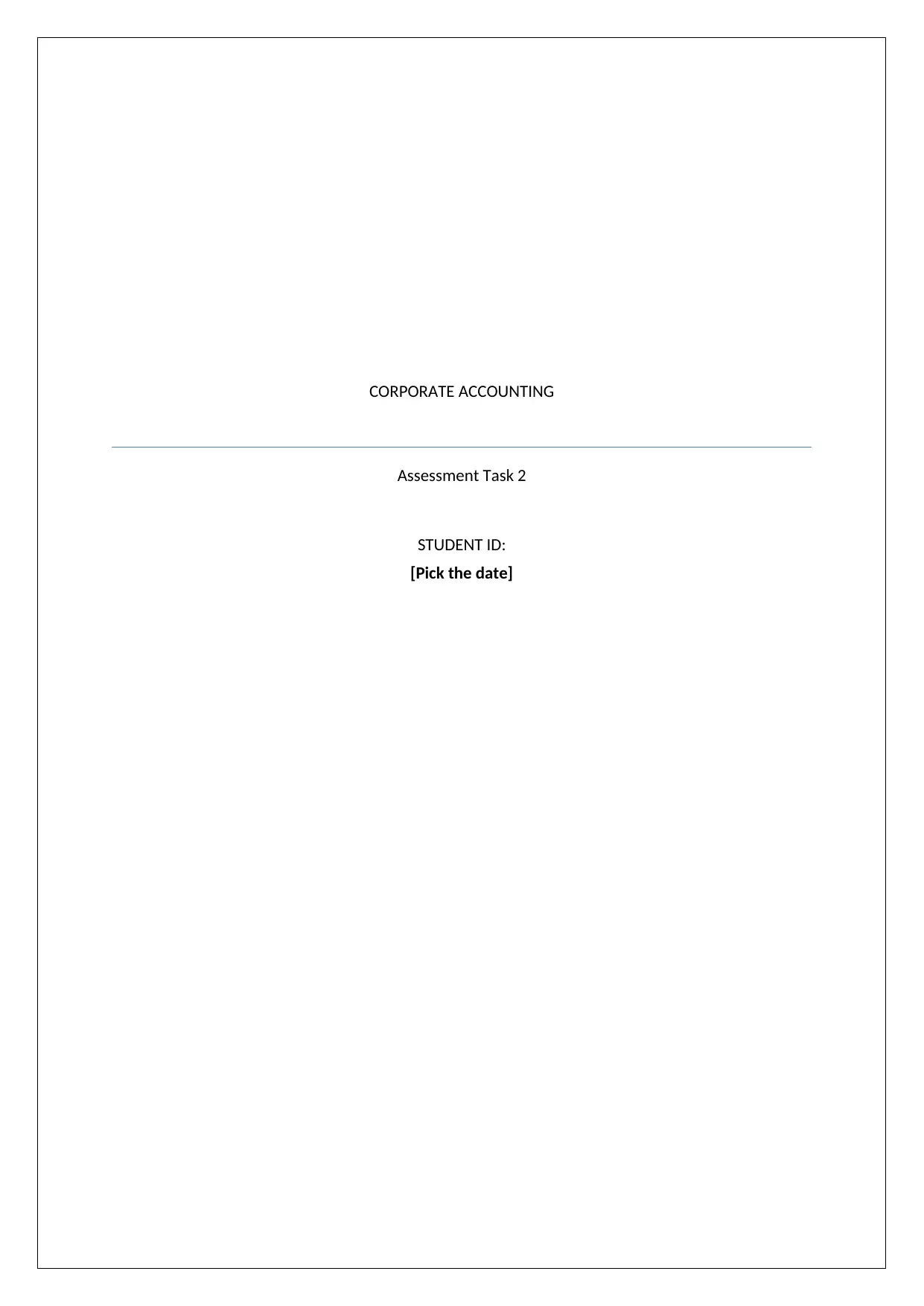
CORPORATE ACCOUNTING
Assessment Task 2
STUDENT ID:
[Pick the date]
Assessment Task 2
STUDENT ID:
[Pick the date]
Secure Best Marks with AI Grader
Need help grading? Try our AI Grader for instant feedback on your assignments.
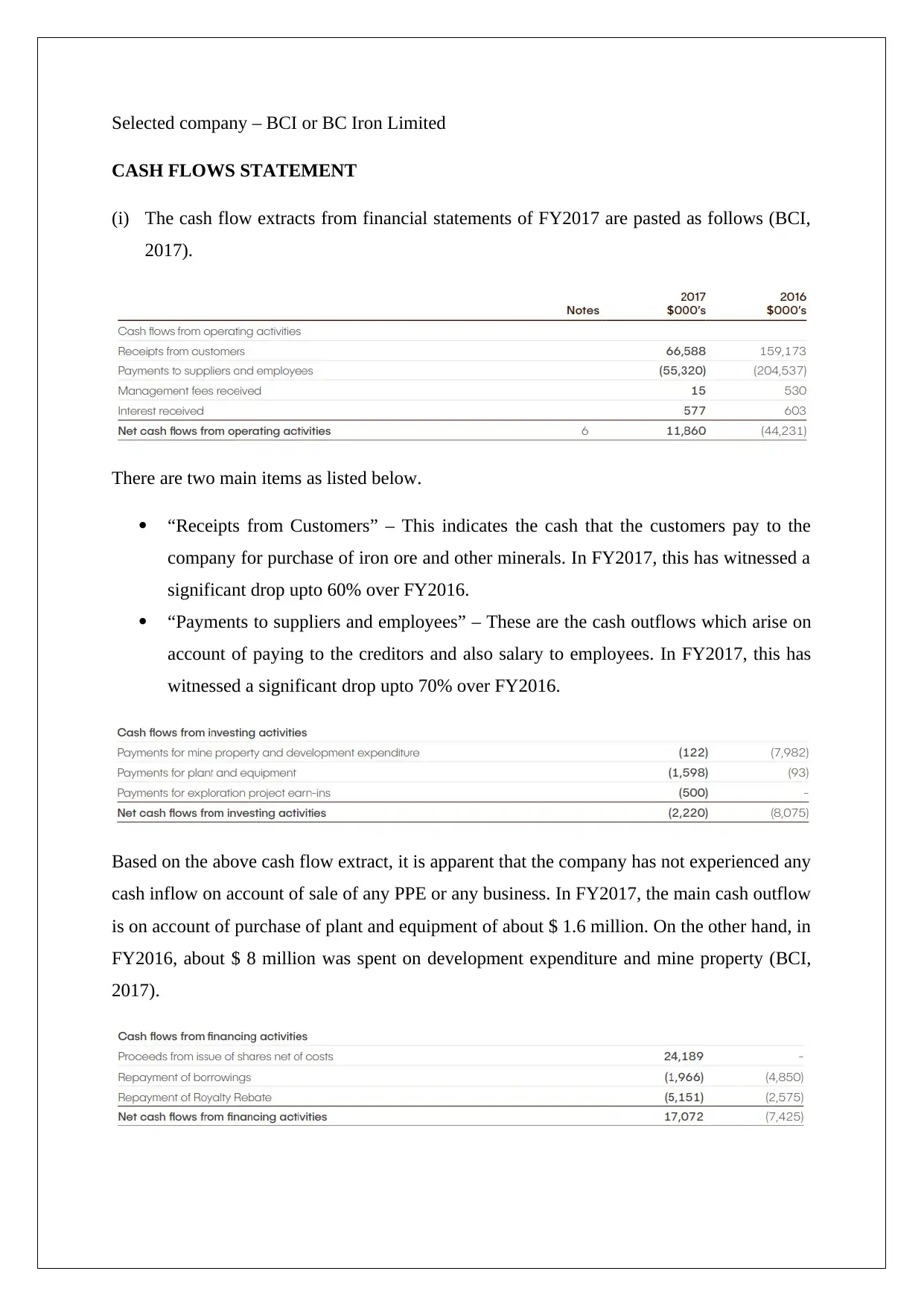
Selected company – BCI or BC Iron Limited
CASH FLOWS STATEMENT
(i) The cash flow extracts from financial statements of FY2017 are pasted as follows (BCI,
2017).
There are two main items as listed below.
“Receipts from Customers” – This indicates the cash that the customers pay to the
company for purchase of iron ore and other minerals. In FY2017, this has witnessed a
significant drop upto 60% over FY2016.
“Payments to suppliers and employees” – These are the cash outflows which arise on
account of paying to the creditors and also salary to employees. In FY2017, this has
witnessed a significant drop upto 70% over FY2016.
Based on the above cash flow extract, it is apparent that the company has not experienced any
cash inflow on account of sale of any PPE or any business. In FY2017, the main cash outflow
is on account of purchase of plant and equipment of about $ 1.6 million. On the other hand, in
FY2016, about $ 8 million was spent on development expenditure and mine property (BCI,
2017).
CASH FLOWS STATEMENT
(i) The cash flow extracts from financial statements of FY2017 are pasted as follows (BCI,
2017).
There are two main items as listed below.
“Receipts from Customers” – This indicates the cash that the customers pay to the
company for purchase of iron ore and other minerals. In FY2017, this has witnessed a
significant drop upto 60% over FY2016.
“Payments to suppliers and employees” – These are the cash outflows which arise on
account of paying to the creditors and also salary to employees. In FY2017, this has
witnessed a significant drop upto 70% over FY2016.
Based on the above cash flow extract, it is apparent that the company has not experienced any
cash inflow on account of sale of any PPE or any business. In FY2017, the main cash outflow
is on account of purchase of plant and equipment of about $ 1.6 million. On the other hand, in
FY2016, about $ 8 million was spent on development expenditure and mine property (BCI,
2017).
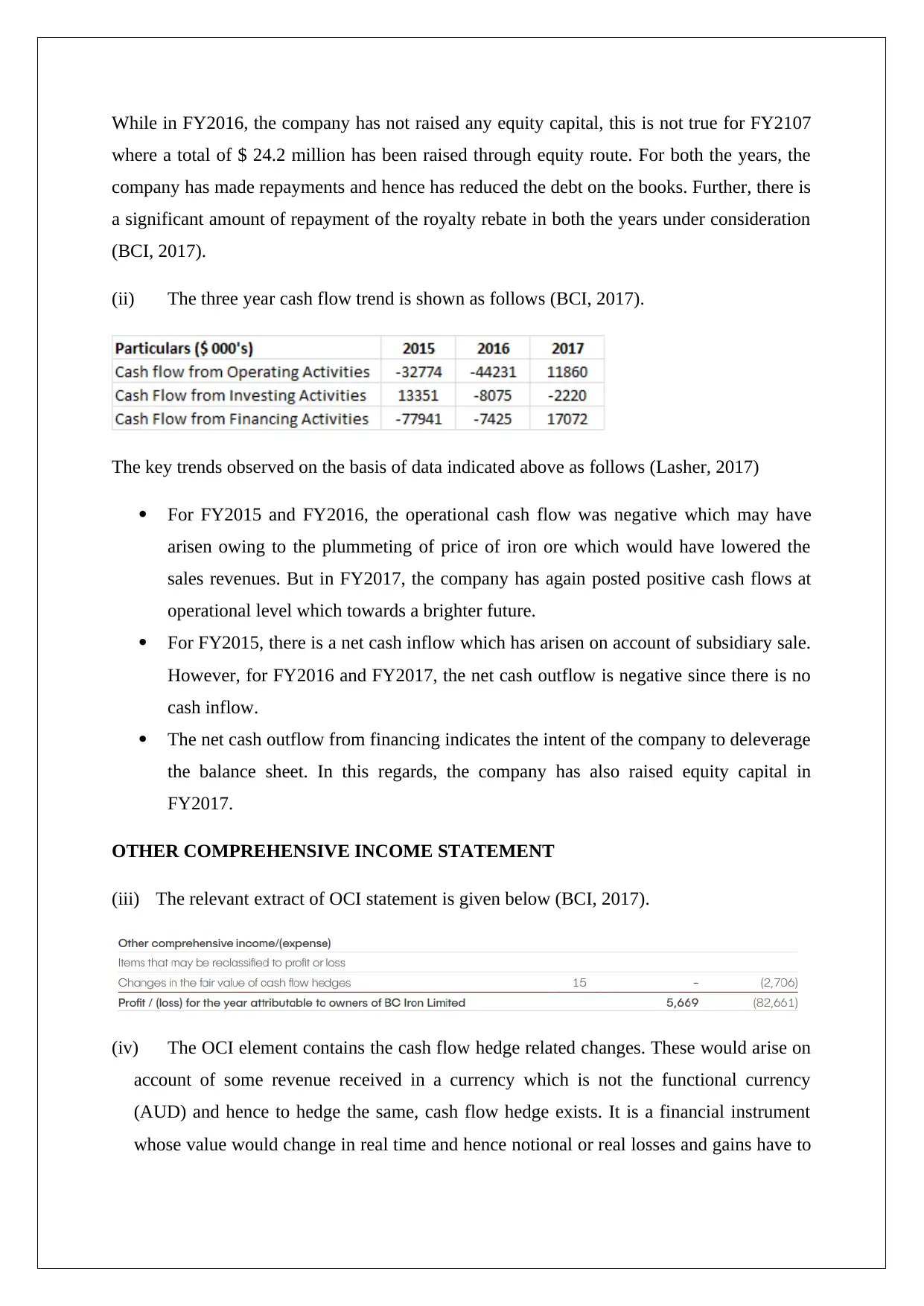
While in FY2016, the company has not raised any equity capital, this is not true for FY2107
where a total of $ 24.2 million has been raised through equity route. For both the years, the
company has made repayments and hence has reduced the debt on the books. Further, there is
a significant amount of repayment of the royalty rebate in both the years under consideration
(BCI, 2017).
(ii) The three year cash flow trend is shown as follows (BCI, 2017).
The key trends observed on the basis of data indicated above as follows (Lasher, 2017)
For FY2015 and FY2016, the operational cash flow was negative which may have
arisen owing to the plummeting of price of iron ore which would have lowered the
sales revenues. But in FY2017, the company has again posted positive cash flows at
operational level which towards a brighter future.
For FY2015, there is a net cash inflow which has arisen on account of subsidiary sale.
However, for FY2016 and FY2017, the net cash outflow is negative since there is no
cash inflow.
The net cash outflow from financing indicates the intent of the company to deleverage
the balance sheet. In this regards, the company has also raised equity capital in
FY2017.
OTHER COMPREHENSIVE INCOME STATEMENT
(iii) The relevant extract of OCI statement is given below (BCI, 2017).
(iv) The OCI element contains the cash flow hedge related changes. These would arise on
account of some revenue received in a currency which is not the functional currency
(AUD) and hence to hedge the same, cash flow hedge exists. It is a financial instrument
whose value would change in real time and hence notional or real losses and gains have to
where a total of $ 24.2 million has been raised through equity route. For both the years, the
company has made repayments and hence has reduced the debt on the books. Further, there is
a significant amount of repayment of the royalty rebate in both the years under consideration
(BCI, 2017).
(ii) The three year cash flow trend is shown as follows (BCI, 2017).
The key trends observed on the basis of data indicated above as follows (Lasher, 2017)
For FY2015 and FY2016, the operational cash flow was negative which may have
arisen owing to the plummeting of price of iron ore which would have lowered the
sales revenues. But in FY2017, the company has again posted positive cash flows at
operational level which towards a brighter future.
For FY2015, there is a net cash inflow which has arisen on account of subsidiary sale.
However, for FY2016 and FY2017, the net cash outflow is negative since there is no
cash inflow.
The net cash outflow from financing indicates the intent of the company to deleverage
the balance sheet. In this regards, the company has also raised equity capital in
FY2017.
OTHER COMPREHENSIVE INCOME STATEMENT
(iii) The relevant extract of OCI statement is given below (BCI, 2017).
(iv) The OCI element contains the cash flow hedge related changes. These would arise on
account of some revenue received in a currency which is not the functional currency
(AUD) and hence to hedge the same, cash flow hedge exists. It is a financial instrument
whose value would change in real time and hence notional or real losses and gains have to
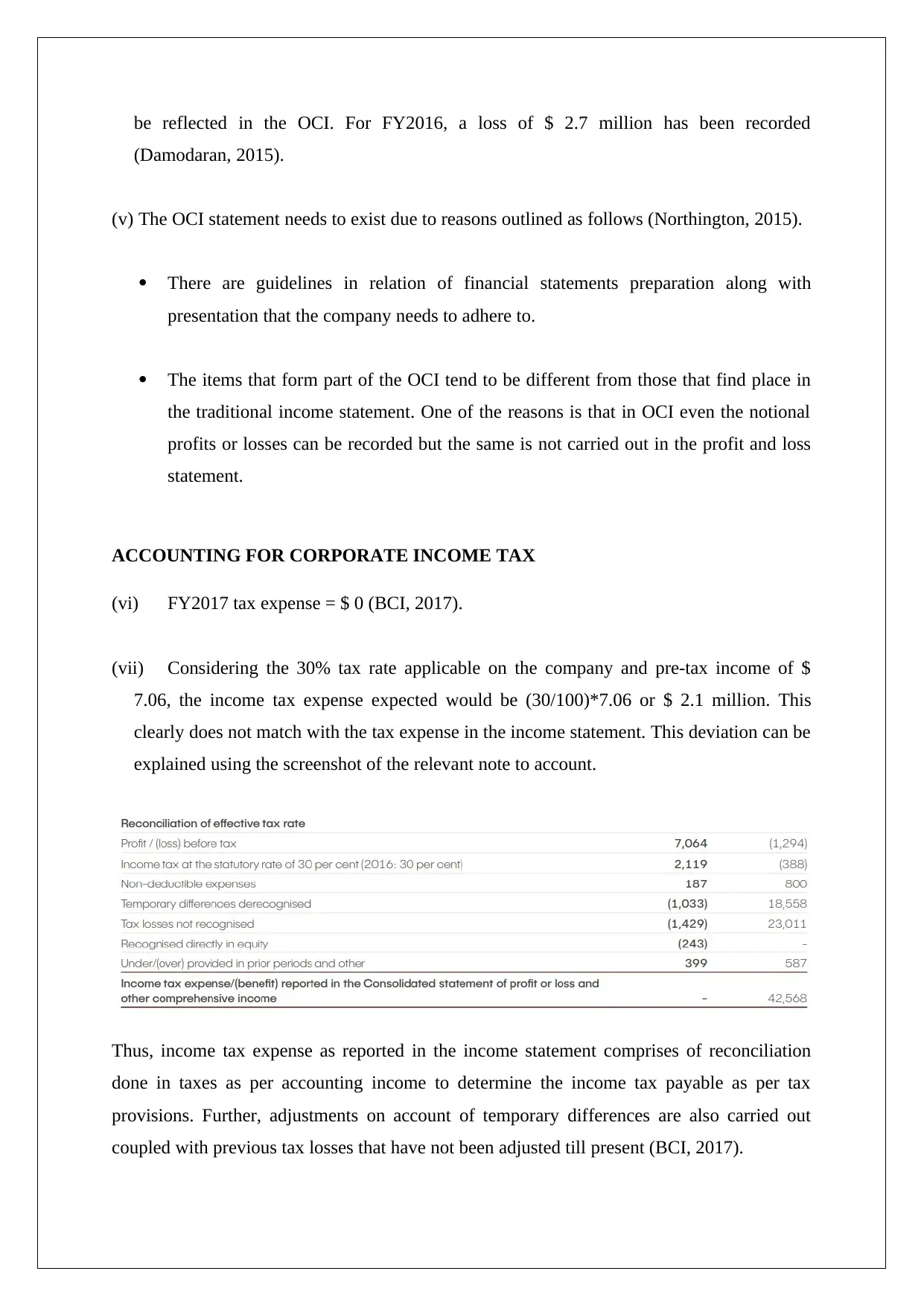
be reflected in the OCI. For FY2016, a loss of $ 2.7 million has been recorded
(Damodaran, 2015).
(v) The OCI statement needs to exist due to reasons outlined as follows (Northington, 2015).
There are guidelines in relation of financial statements preparation along with
presentation that the company needs to adhere to.
The items that form part of the OCI tend to be different from those that find place in
the traditional income statement. One of the reasons is that in OCI even the notional
profits or losses can be recorded but the same is not carried out in the profit and loss
statement.
ACCOUNTING FOR CORPORATE INCOME TAX
(vi) FY2017 tax expense = $ 0 (BCI, 2017).
(vii) Considering the 30% tax rate applicable on the company and pre-tax income of $
7.06, the income tax expense expected would be (30/100)*7.06 or $ 2.1 million. This
clearly does not match with the tax expense in the income statement. This deviation can be
explained using the screenshot of the relevant note to account.
Thus, income tax expense as reported in the income statement comprises of reconciliation
done in taxes as per accounting income to determine the income tax payable as per tax
provisions. Further, adjustments on account of temporary differences are also carried out
coupled with previous tax losses that have not been adjusted till present (BCI, 2017).
(Damodaran, 2015).
(v) The OCI statement needs to exist due to reasons outlined as follows (Northington, 2015).
There are guidelines in relation of financial statements preparation along with
presentation that the company needs to adhere to.
The items that form part of the OCI tend to be different from those that find place in
the traditional income statement. One of the reasons is that in OCI even the notional
profits or losses can be recorded but the same is not carried out in the profit and loss
statement.
ACCOUNTING FOR CORPORATE INCOME TAX
(vi) FY2017 tax expense = $ 0 (BCI, 2017).
(vii) Considering the 30% tax rate applicable on the company and pre-tax income of $
7.06, the income tax expense expected would be (30/100)*7.06 or $ 2.1 million. This
clearly does not match with the tax expense in the income statement. This deviation can be
explained using the screenshot of the relevant note to account.
Thus, income tax expense as reported in the income statement comprises of reconciliation
done in taxes as per accounting income to determine the income tax payable as per tax
provisions. Further, adjustments on account of temporary differences are also carried out
coupled with previous tax losses that have not been adjusted till present (BCI, 2017).
Secure Best Marks with AI Grader
Need help grading? Try our AI Grader for instant feedback on your assignments.
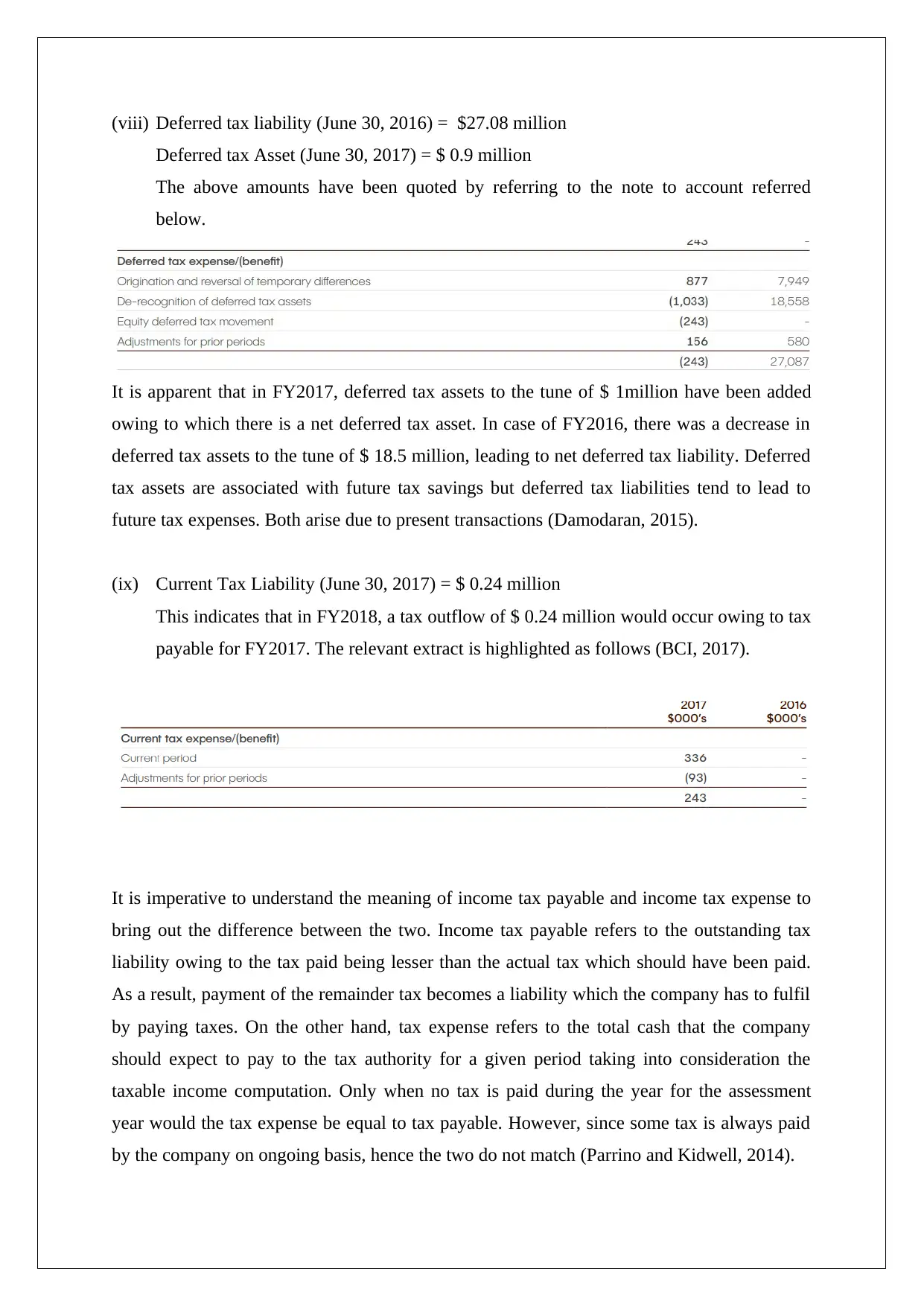
(viii) Deferred tax liability (June 30, 2016) = $27.08 million
Deferred tax Asset (June 30, 2017) = $ 0.9 million
The above amounts have been quoted by referring to the note to account referred
below.
It is apparent that in FY2017, deferred tax assets to the tune of $ 1million have been added
owing to which there is a net deferred tax asset. In case of FY2016, there was a decrease in
deferred tax assets to the tune of $ 18.5 million, leading to net deferred tax liability. Deferred
tax assets are associated with future tax savings but deferred tax liabilities tend to lead to
future tax expenses. Both arise due to present transactions (Damodaran, 2015).
(ix) Current Tax Liability (June 30, 2017) = $ 0.24 million
This indicates that in FY2018, a tax outflow of $ 0.24 million would occur owing to tax
payable for FY2017. The relevant extract is highlighted as follows (BCI, 2017).
It is imperative to understand the meaning of income tax payable and income tax expense to
bring out the difference between the two. Income tax payable refers to the outstanding tax
liability owing to the tax paid being lesser than the actual tax which should have been paid.
As a result, payment of the remainder tax becomes a liability which the company has to fulfil
by paying taxes. On the other hand, tax expense refers to the total cash that the company
should expect to pay to the tax authority for a given period taking into consideration the
taxable income computation. Only when no tax is paid during the year for the assessment
year would the tax expense be equal to tax payable. However, since some tax is always paid
by the company on ongoing basis, hence the two do not match (Parrino and Kidwell, 2014).
Deferred tax Asset (June 30, 2017) = $ 0.9 million
The above amounts have been quoted by referring to the note to account referred
below.
It is apparent that in FY2017, deferred tax assets to the tune of $ 1million have been added
owing to which there is a net deferred tax asset. In case of FY2016, there was a decrease in
deferred tax assets to the tune of $ 18.5 million, leading to net deferred tax liability. Deferred
tax assets are associated with future tax savings but deferred tax liabilities tend to lead to
future tax expenses. Both arise due to present transactions (Damodaran, 2015).
(ix) Current Tax Liability (June 30, 2017) = $ 0.24 million
This indicates that in FY2018, a tax outflow of $ 0.24 million would occur owing to tax
payable for FY2017. The relevant extract is highlighted as follows (BCI, 2017).
It is imperative to understand the meaning of income tax payable and income tax expense to
bring out the difference between the two. Income tax payable refers to the outstanding tax
liability owing to the tax paid being lesser than the actual tax which should have been paid.
As a result, payment of the remainder tax becomes a liability which the company has to fulfil
by paying taxes. On the other hand, tax expense refers to the total cash that the company
should expect to pay to the tax authority for a given period taking into consideration the
taxable income computation. Only when no tax is paid during the year for the assessment
year would the tax expense be equal to tax payable. However, since some tax is always paid
by the company on ongoing basis, hence the two do not match (Parrino and Kidwell, 2014).
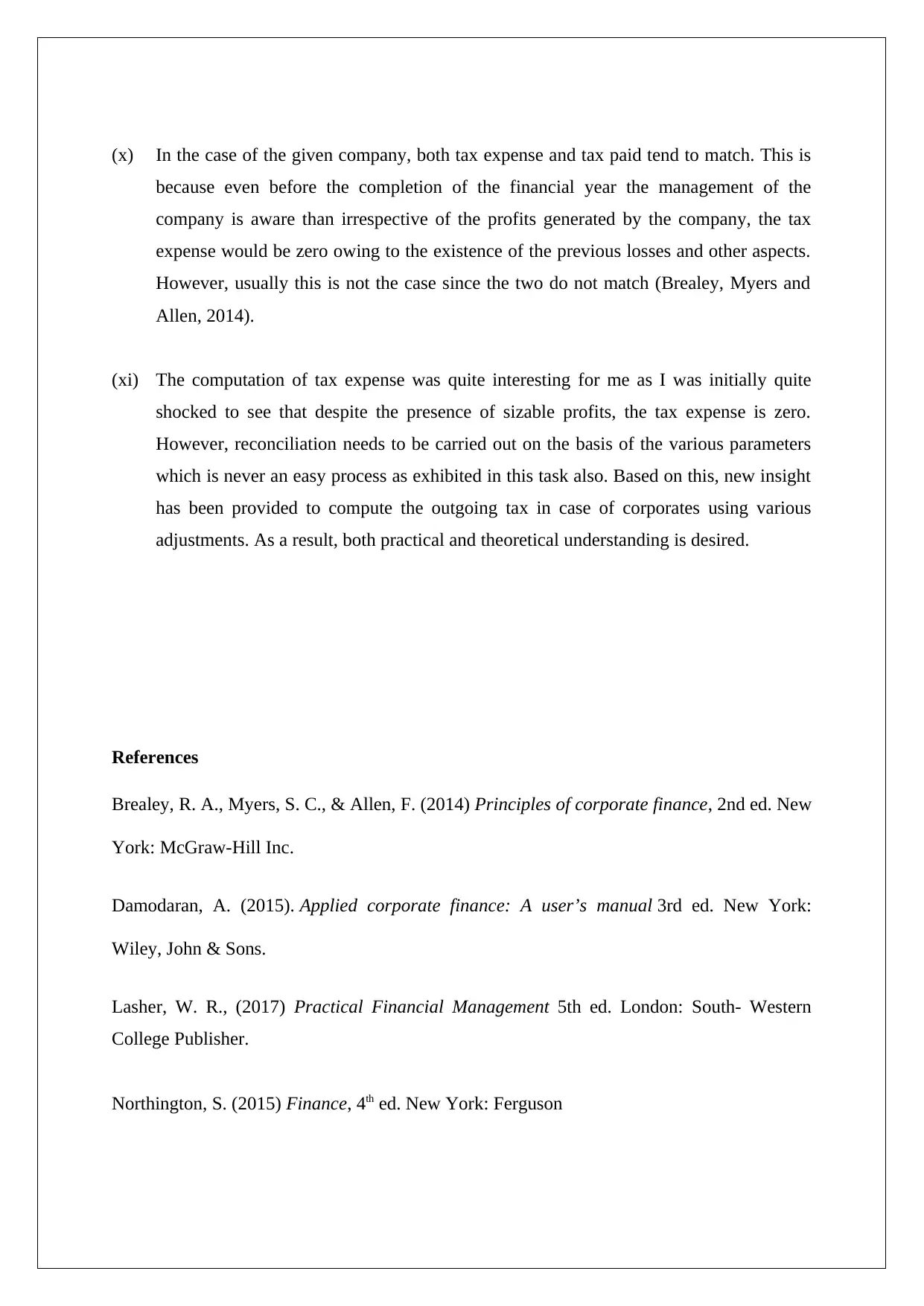
(x) In the case of the given company, both tax expense and tax paid tend to match. This is
because even before the completion of the financial year the management of the
company is aware than irrespective of the profits generated by the company, the tax
expense would be zero owing to the existence of the previous losses and other aspects.
However, usually this is not the case since the two do not match (Brealey, Myers and
Allen, 2014).
(xi) The computation of tax expense was quite interesting for me as I was initially quite
shocked to see that despite the presence of sizable profits, the tax expense is zero.
However, reconciliation needs to be carried out on the basis of the various parameters
which is never an easy process as exhibited in this task also. Based on this, new insight
has been provided to compute the outgoing tax in case of corporates using various
adjustments. As a result, both practical and theoretical understanding is desired.
References
Brealey, R. A., Myers, S. C., & Allen, F. (2014) Principles of corporate finance, 2nd ed. New
York: McGraw-Hill Inc.
Damodaran, A. (2015). Applied corporate finance: A user’s manual 3rd ed. New York:
Wiley, John & Sons.
Lasher, W. R., (2017) Practical Financial Management 5th ed. London: South- Western
College Publisher.
Northington, S. (2015) Finance, 4th ed. New York: Ferguson
because even before the completion of the financial year the management of the
company is aware than irrespective of the profits generated by the company, the tax
expense would be zero owing to the existence of the previous losses and other aspects.
However, usually this is not the case since the two do not match (Brealey, Myers and
Allen, 2014).
(xi) The computation of tax expense was quite interesting for me as I was initially quite
shocked to see that despite the presence of sizable profits, the tax expense is zero.
However, reconciliation needs to be carried out on the basis of the various parameters
which is never an easy process as exhibited in this task also. Based on this, new insight
has been provided to compute the outgoing tax in case of corporates using various
adjustments. As a result, both practical and theoretical understanding is desired.
References
Brealey, R. A., Myers, S. C., & Allen, F. (2014) Principles of corporate finance, 2nd ed. New
York: McGraw-Hill Inc.
Damodaran, A. (2015). Applied corporate finance: A user’s manual 3rd ed. New York:
Wiley, John & Sons.
Lasher, W. R., (2017) Practical Financial Management 5th ed. London: South- Western
College Publisher.
Northington, S. (2015) Finance, 4th ed. New York: Ferguson
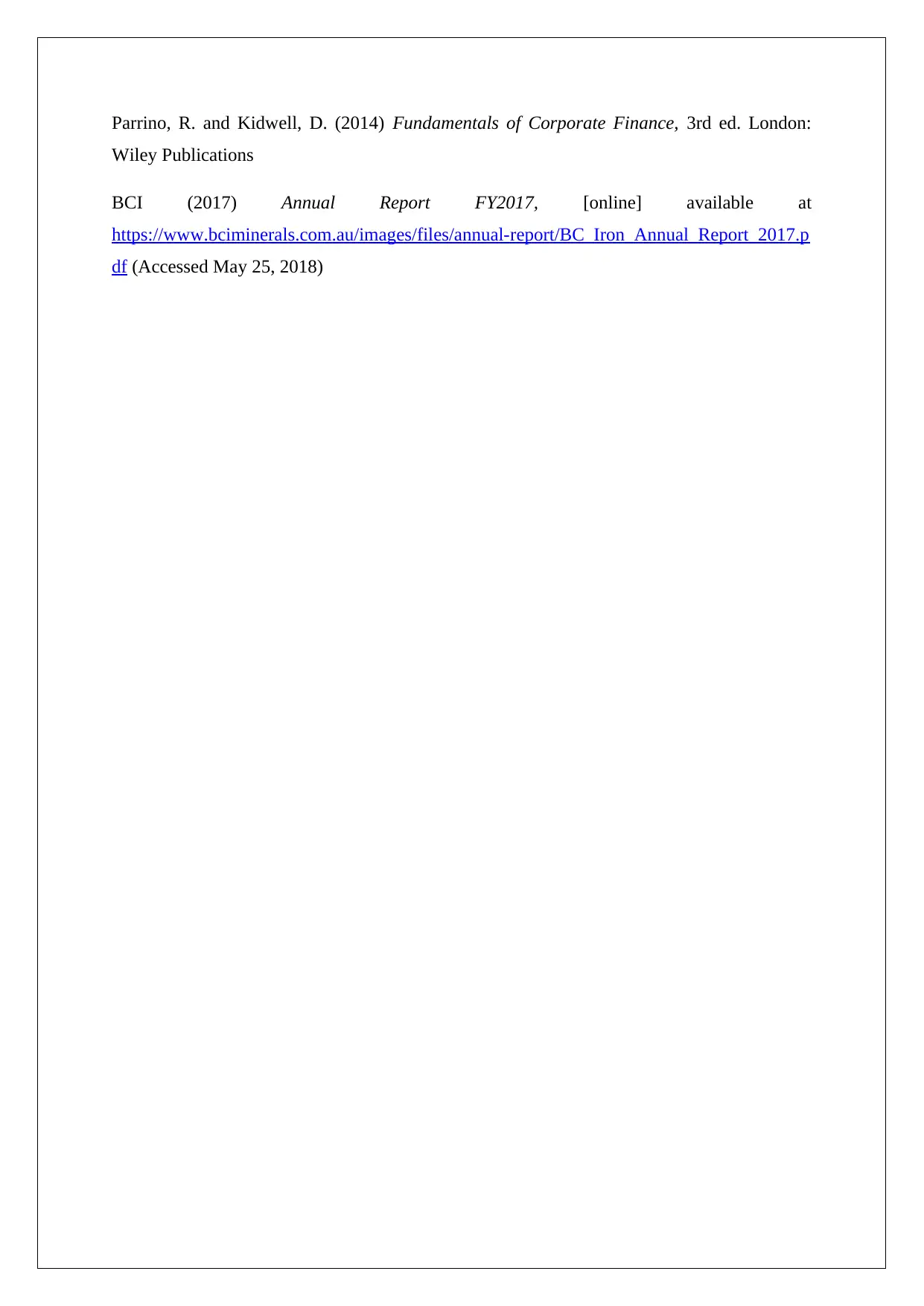
Parrino, R. and Kidwell, D. (2014) Fundamentals of Corporate Finance, 3rd ed. London:
Wiley Publications
BCI (2017) Annual Report FY2017, [online] available at
https://www.bciminerals.com.au/images/files/annual-report/BC_Iron_Annual_Report_2017.p
df (Accessed May 25, 2018)
Wiley Publications
BCI (2017) Annual Report FY2017, [online] available at
https://www.bciminerals.com.au/images/files/annual-report/BC_Iron_Annual_Report_2017.p
df (Accessed May 25, 2018)
1 out of 7
Related Documents
Your All-in-One AI-Powered Toolkit for Academic Success.
+13062052269
info@desklib.com
Available 24*7 on WhatsApp / Email
![[object Object]](/_next/static/media/star-bottom.7253800d.svg)
Unlock your academic potential
© 2024 | Zucol Services PVT LTD | All rights reserved.





